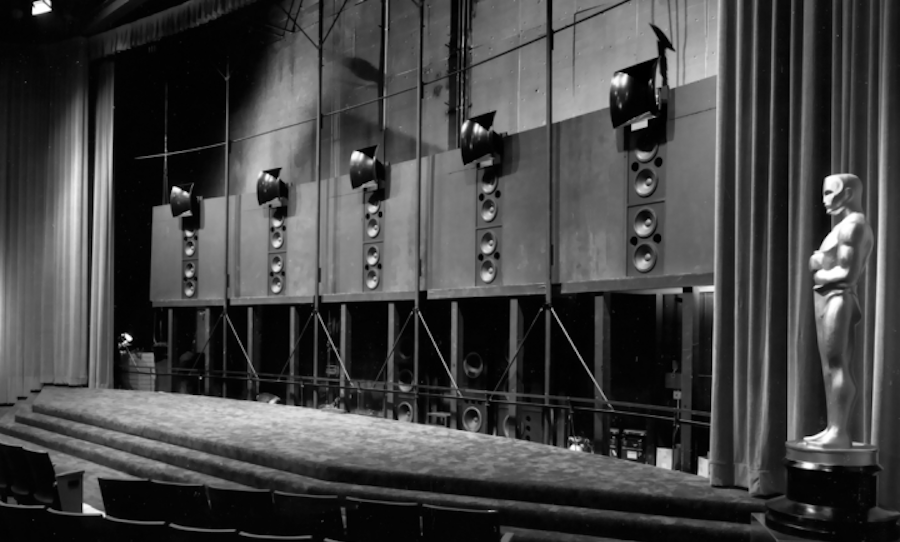Early cinema speakers were less than impressive, but if there’s someone you can thank for improving your motion picture experience, it’s James B. Lansing (A man whose initials, you may notice, are JBL).
When was the last time you paid attention to cinema speakers? Apart from a few units on the sidewalls, most people don’t actually get to see them. They’re hidden behind the screen. But I’m sure most would agree that the crisp sound perfectly matches the spectacle of the motion picture experience. Theatre systems are powerful. You feel the sound waves hit your body and travel right through to the back of your seat, but they weren’t always this way. 
James B. Lansing revolutionised cinema sound and produced some of the most cutting edge audio technologies ever made, still in use today.
Early Cinema Sound
In the early days of cinema, speaker systems were in their infancy and sound mostly consisted of effects and music. In 1927 things changed. Warner released The Jazz Singer, the first film to feature synchronised dialogue and singing, which by the early 1930s was becoming commonplace.
Though theatre sound was becoming more and more important, speakers hadn’t yet been produced with the cinema specifically in mind. Western Electric was the predominant manufacturer for speakers at the time, and their distribution branch Electrical Research Products Incorporated (ERPI), readily serviced the film industry.
Western Electric had the vast resources of Bell Laboratories at their disposal, but their early speaker systems were relatively basic. Metro-Goldwyn-Mayer’s sound department weren’t too impressed, specifically with the reach of the mid-range and delay issues between the sub and the tweeter.
A New Sound
Unsatisfied with his current options, head of MGM’s sound department, Douglas Shearer, decided that he’d build his own system. Shearer enlisted team of engineers and designers including John Hilliard, Robert Stephens and John F. Blackburn.
Blackburn made the recommendation of recruiting a bright young audio engineer by the name of James B. Lansing to manufacture components for the MGM system. Lansing had been manufacturing audio systems such as 15XS speakers and 284 drivers as part of his family business for much of the last decade. Although he hadn’t tackled anything on this scale before, his contribution would go on to change cinema history and speaker design forever.
Lansing Manufacturing built the 285 compression drivers and the 15XS bass drivers, both major components of the resulting system:1 the groundbreaking Shearer Horn. The new set of speakers used high-frequency multicellular horns and an annular slit plug for accentuated highs, while the lows were covered by a large horn incorporating 15-inch woofers and an open back design.
The two-way system was a massive success and went on to win an award from the Academy of Motion Picture Arts and Sciences for technical excellence in 1936. It set a new standard for sound in theatre, and the basic design principle was imitated by most other manufacturers around the world.
Iconic Sound
With the momentum of the Shearer Horn running through the company, Lansing Manufacturing produced a new theatre system on their own, simply named ‘Iconic’. Released in 1937, it is considered one of the most influential speakers of all time, as it was the first unit to use a two-way system with a 15″ bass-reflex driver, with a high-frequency horn on top. The same configuration found its way into PA systems, home speakers and studio monitors, and even in modern times, it’s still the most common basic setup for professional loudspeakers.
Things were looking good for Lansing Manufacturing but in 1939, Lansing’s partner Ken Decker was killed in a plane crash and without his business savvy mind the company began to struggle. Altec Service Corporation saw the value of investing in speaker components and a new firm, The Altec Lansing Corporation, was formed. Lansing finally had the financial wiggle room to develop cutting edge speaker technology to his heart’s content.
Voice of the Theatre
A model named the A-4 was released in 1944, which was touted as ‘The Voice of the Theatre’. It was a huge two-way system that towered eight feet into the air, crowned with a high-frequency annular split phaser and a three-inch voice coil. Importantly, the system pioneered a closed low-frequency enclosure as well as a new low-frequency transducer that made use of flat wire for the first time. The horn design throughout the mid-bass region gave the system an incredible rumble that would have left cinema-goers in the 40s aghast.
James B. Lansing Sound, Incorporated
Lansing broke away from Altec in 1946, and his new company came to be called ‘James B. Lansing Sound Incorporated’, with his initials JBL printed on each product. During this period he developed the D175 high-frequency driver, which incredibly is still in the JBL catalogue to this day. Lansing was an intuitive audio engineer, however, he struggled with personal problems and deteriorating business conditions towards the end of the decade, taking his own life in 1949.
The company soon adopted his initials as their official title and his legacy continued throughout the following decades. The company began to diversify into other areas, with Leo Fender using technology from the D130 loudspeaker for electric guitar amplification. JBL branched its way into smaller scale systems such as home theatres and studio monitors like the 4320s which became an industry standard, as well as larger systems, such as the Grateful Dead’s infamous ‘Wall of Sound’ or the huge line array systems used at Woodstock in 1969.
In the same year, Harman Professional purchased JBL, which continued to support the company in refining their audio technology over the ensuing years. JBL and Harmon Professional continue to be staples in cinemas around the world to this day.
Find out more about JBL’s modern product range on their website.



